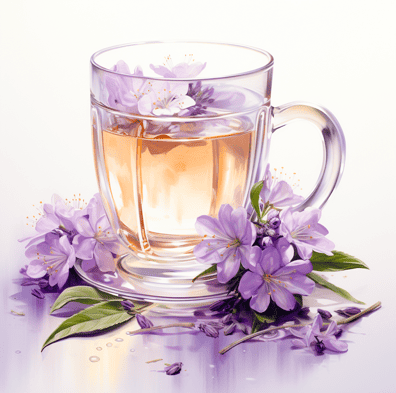
How is Jasmine Tea Made? It’s not just about tossing tea leaves into hot water; it’s an art form that enriches your tea experience and boosts your skincare routine.
Hi, I’m Hazel
I gave up on skincare after years of issues with acne and sensitive skin.
But after going plant-based, my skin cleared up and even started to glow. Now I help women reveal their natural beauty with simple, delicious plant-based food.
I also used to be a nurse, and love nerding out on nutritional science (high-quality science, that is).

As usual, this post is based on the strongest nutritional evidence I could find with a focus on the simplest, most delicious foods
…because who has time to waste on actions that don’t work?
The quick version:
Jasmine tea is meticulously crafted by layering freshly picked jasmine flowers with tea leaves, allowing them to naturally infuse overnight. This process, repeated several times, imbues the tea with a delicate and natural floral fragrance. The tea leaves absorb the essential oils and aroma of jasmine, creating a soothing and aromatic beverage.
The Art of Jasmine Tea
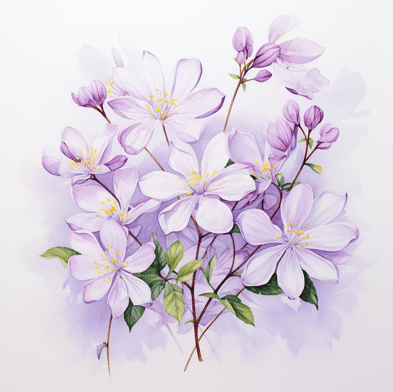
Infusing the Scent
The enchanting process of scent infusion is the heart of what makes jasmine tea the most famous scented tea in the world. This step begins with the scenting process during early summer, when jasmine flower buds are carefully harvested at their most fragrant—usually as dusk falls.
Fresh jasmine flowers, including the delicate jasmine silver needle and prized jasmine pearl tea, are meticulously placed among the tea leaves.
Over several nights, typically in late summer, these blossoms open and the leaves naturally absorb the delicate flavour and natural aroma of the flowers. This crucial step transforms ordinary tea leaves into a fragrant gift that promotes relaxation and skin health, using the traditional methods to ensure the best jasmine tea.
Selecting the Leaves
Choosing the right tea leaves is the next step in our jasmine tea journey.
Whether it’s the robust flavour of black tea, the subtlety of white tea, or the classic green tea leaves, each base plays a pivotal role in the final taste. This choice affects not just the flavour but also how your skin benefits from each cup.
The jasmine harvest is timed to coincide with the peak of tea leaf quality to ensure that the infusion of fresh flower petals and tea leaves captures the full essence of the season, providing a tea experience that is as beneficial as it is delightful.
Layering Technique
The creation of jasmine tea is akin to painting—each layer adds depth and complexity. By alternating layers of tea leaves with jasmine blooms, the leaves slowly imbibe the floral essences. This ensures that the flavour is evenly distributed throughout the tea.
This method is not just about taste; it’s also about maximising the therapeutic properties that can help soothe your skin from within.
Timing the Scent Transfer
Getting the timing right is crucial for capturing the essence of jasmine buds and fresh jasmine blossoms at their peak. The process involves monitoring the temperature and humidity to facilitate the perfect transfer of fragrance. This precise timing helps preserve the antioxidants and anti-inflammatory properties of the tea, making it a powerful ally in your skincare routine.
Types of Jasmine Tea
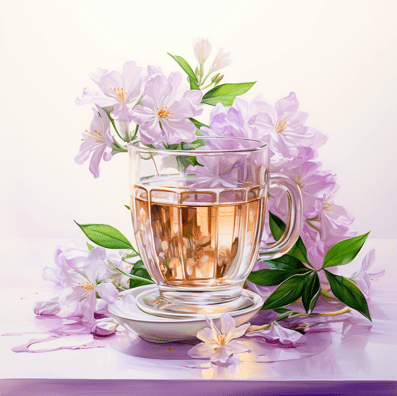
Herbal
For those who prefer a purely herbal option, common jasmine without traditional tea leaves offers a caffeine-free alternative.
This version harnesses the full potential of the jasmine plant, providing a gentle, soothing drink.
How to make it:
To make this herbal tea, simply steep fresh or dried flowers in hot water for about 5 to 7 minutes. This allows the natural aroma of the flowers to infuse into the water, creating a brew that’s perfect for unwinding before bed.
Loose Leaf
Using loose leaf tea provides a richer experience, as the full leaves unfurl in hot water, releasing a complex, more pronounced flavour and a higher concentration of beneficial compounds.
A green tea base, derived from the Camellia sinensis plant, is especially effective for its anti-aging benefits (1).
How to make it:
To brew, use about one teaspoon of jasmine loose leaf tea per cup of hot water and steep for 3 to 5 minutes. The leaves can be re-infused several times, with each steeping releasing different aspects of the floral taste and aroma.
Tea Bags
For convenience without compromise, jasmine tea is also available in tea bags.
This option is perfect for busy mornings or office breaks, offering a quick yet effective beauty boost.
How to make it:
Simply place a tea bag in a cup, add hot water, and steep for 2 to 3 minutes. This method is ideal for those who appreciate the jasmine tea blends but need a quicker preparation time.
Iced Jasmine Tea
To make, you can use either the loose leaf or tea bag methods mentioned above.
Brew the tea as usual but make it stronger since it will be diluted with ice. Once brewed, let the tea cool to room temperature and then serve over ice. For a refreshing twist, add a slice of lemon or a few mint leaves.
Each variation of jasmine tea offers unique benefits, allowing you to tailor your tea-drinking experience to your specific lifestyle and skincare needs. Whether you opt for the herbal, loose leaf, or bagged version, jasmine tea is a delightful addition to your wellness routine. Incorporating oolong tea as a base tea in loose leaf or bag form can also enhance the experience, providing a richer flavour profile and a slightly higher caffeine level compared to green tea. This variety caters to tea makers and drinkers who are exploring beyond traditional green tea bases in their jasmine tea blends.
Health and Beauty Benefits
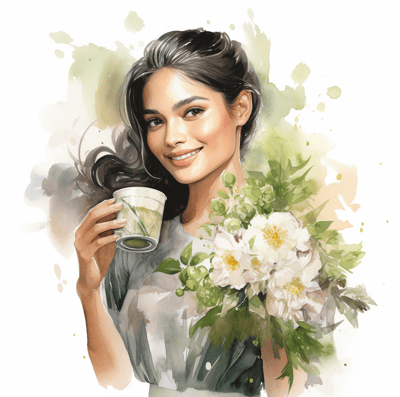
Calming Effects: This tea is renowned for its soothing properties that help reduce stress levels. Lower stress can lead to clearer, healthier skin, enhancing your daily skincare routine.
Antioxidant Powerhouse: Rich in antioxidants, particularly when brewed from a green tea base, it combats free radicals (2). This action helps reduce skin inflammation and promotes cellular repair, contributing to a youthful and radiant complexion.
Boosts Immunity: Regular consumption strengthens the immune system (2). A robust immune system supports overall health, making jasmine tea a key element of a health-conscious lifestyle.
By integrating jasmine tea into your routine, you not only enjoy a peaceful moment but also support your skin’s health and vitality, leveraging its therapeutic benefits to complement your beauty regimen.
You’ll also love:
How to Glow Up With Jasmine Green Tea Skin Secrets
Ways to Enjoy Jasmine Tea
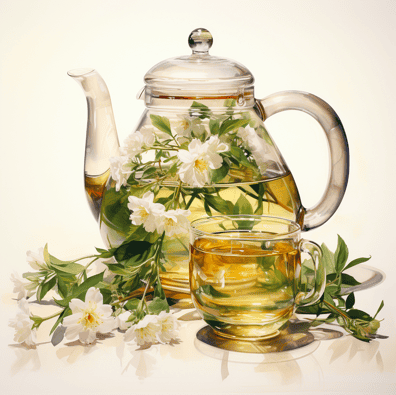
Ideal Brewing
To get the most out of your tea, proper brewing is key.
The perfect cup of jasmine tea starts with the right water temperature—not boiling, but just hot enough to extract the delicate flavours without scorching the leaves.
Whether you choose loose leaf tea or tea bags, ensuring your water is around 175-185°F (80-85°C) will make all the difference in flavour and health benefits.
Creative Uses
Jasmine tea is versatile. Beyond drinking it in its traditional form, you can incorporate jasmine pearls or rolled pearls into your diet through various creative ways.
Consider cooling the brewed tea to make iced tea, adding it to smoothies for a floral twist, or even using it in culinary recipes like marinades and desserts. Each method offers a unique taste experience while still delivering the skin and health benefits.
Conclusion
From the careful layering technique to the final sip, understanding how is jasmine tea made enriches not only your palate but also your health. Whether you’re sipping it to wind down after a busy day or incorporating it into your beauty regimen, jasmine tea offers a blend of benefits that cater to both wellness and pleasure. Embrace the subtle art of jasmine tea and make it a part of your daily routine to truly see and feel the difference in your skin and spirit.
References
Most references below will link to the original peer-reviewed study itself. However, sometimes I will link to a video over at NutritionFacts.org instead, which is by far the single best resource of brutally transparent nutritional evidence you will ever see. Dr Greger tells a great story about the realities of the science and if I think you will benefit more from one of his videos, the link will take you there instead.
Happy nerding!
- Heinrich U, Moore CE, De Spirt S, Tronnier H, Stahl W. Green tea polyphenols provide photoprotection, increase microcirculation, and modulate skin properties of women. J Nutr. 2011;141(6):1202-1208. doi:10.3945/jn.110.136465
- Carlsen MH, Halvorsen BL, Holte K, et al. The total antioxidant content of more than 3100 foods, beverages, spices, herbs and supplements used worldwide. Nutr J. 2010;9:3. Published 2010 Jan 22. doi:10.1186/1475-2891-9-3
- Pisoschi AM, Pop A, Iordache F, et al. Antioxidant, anti-inflammatory and immunomodulatory roles of vitamins in COVID-19 therapy. Eur J Med Chem. 2022;232:114175. doi:10.1016/j.ejmech.2022.114175